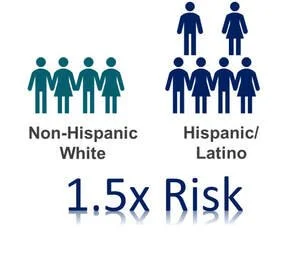Alzheimer's and Latino Population
Latinos have a 50% greater risk of developing Alzheimer’s disease than non-Hispanic white people. They are also more likely to show symptoms earlier, but be diagnosed later, and live longer with the disease. (Alz.org)
Around 18% of the United States population identifies as Hispanic/Latino, and the number is growing. As the population grows, so does the number of Hispanic/Latino older adults.
With age being the biggest risk factor for Alzheimer’s disease related dementia (ADRD) and an increasing Hispanic/Latino older adult population as well Hispanics/Latinos tending to live longer than other cultural groups, the number of Hispanic/Latino adults diagnosed with ADRD is expected to grow nine times or greater by 2060.
While there are similarities in each cultural group’s Alzheimer’s disease experience, such as problems with memory, Hispanics/Latinos may start experiencing symptoms as much as 7 years earlier than non-Hispanic White individuals. However, Hispanics/Latinos often wait longer to seek help. The symptoms can be more severe and harder to treat by this time. The disease can also look different, and Hispanics/Latinos live longer with the disease, the reasons being largely unknown at this time.
As well as getting diagnosed later, Hispanic/Latinos are less likely to take medication. The numbers can vary, but they can be as much as 40% less than non-Hispanic white individuals. This can be due to issues of trust and access to medical care, as well as perceptions of what is “normal aging”.
While we still do not know exactly what causes Alzheimer’s disease, several factors can increase our risk of getting the disease. One of these, a genetic factor known as apolipoprotein E4 (apoE4), has consistently been linked to a greater risk for Alzheimer's Disease in non-Hispanic White individuals, but not in Hispanic/Latino individuals. Instead, other health factors such as hypertension and diabetes, as well as social determinants of health, explain some of the risks in Hispanic/Latino individuals.
Despite the differences Hispanics/Latinos have in disease risk and rates, little is known about why these differences exist. While Hispanics/Latinos represent 18% of the United States population, less than 9% of the research participants in the NACC (The National Alzheimer's Coordinating Center) data set are Hispanic/Latino.




